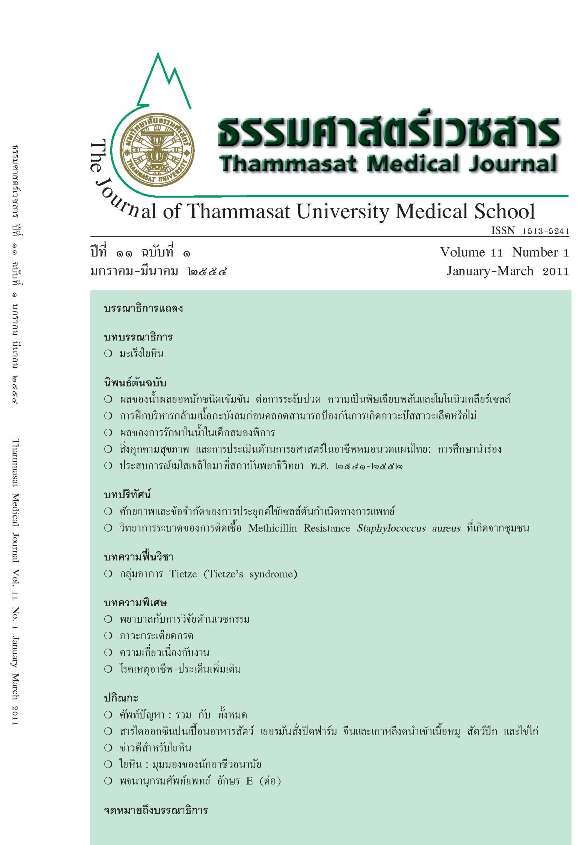Aquatic therapeutic effects in children with cerebral palsy
Keywords:
Cerebral palsy, Aquatic therapy, Gross motor functionAbstract
Background: Children with cerebral palsy should receive physical therapy training for correcting posture, improvingmotor development and preventing complications. Aquatic therapy is an alternative treatment forchildren with cerebral palsy. In water, muscle can contract easier than on land. Children have funand an interest in training program.
Objective: To study aquatic therapeutic effects in children with cerebral palsy.
Method: Five children with cerebral palsy were assessed passive range of motion using standard goniometer,gross motor function using Gross Motor Function Measure-66 (GMFM-66), heart rate, blood pressureand respiratory rate at rest before and after the treatment. The aquatic training program consisted ofbalance training, walking training, neck and trunk muscle training and range of motion exercise ofupper and lower extremities for 30 minutes a day, 2 days/week for 3 months. Wilcoxon-Signed Ranktest was used to test the differences of all variables before and after treatment.
Results: 3 male and 2 female children with cerebral palsy with the average age of 2.4 ± 2 years were includedin this study. The scores of GMFM-66 were found to be a statistically significantly difference beforeand after treatment: 41.0 ± 5.7 score, (95% CI, 29.6 to 52.4 score) and 45.5 ± 4.9 score, (95% CI,35.7 to 55.3 score) respectively, p < 0.05. No statistically significant differences were found betweenbefore and after treatment in passive range of motion, resting heart rate: 100 ± 25.5 bpm, (95% CI,49 to 151 bpm) and 122 ± 23.0 bpm, (95% CI, 76 to 168 bpm) respectively, resting blood pressure:95/60 ± 10 mmHg, (95% CI, 75 to 115 mmHg) and 105/60 ± 10 mmHg, (95% CI, 85 to 125mmHg) respectively and resting respiratory rate: 36 ± 13.5 bpm, (95% CI, 9 to 63 bpm) and 28± 9.8 bpm, (95% CI, 8.4 to 47.6 bpm) respectively.
Conclusion: Aquatic therapy in children with cerebral palsy for 30 minutes a day, 2 days/week for 3 monthscould improve motor development as indicated by a statistically significantly increase in GMFM-66score.
Key words: Cerebral palsy, Aquatic therapy, Gross motor function


